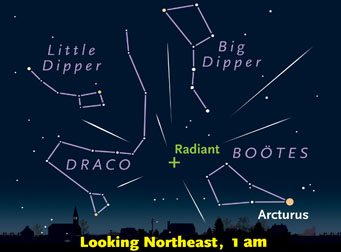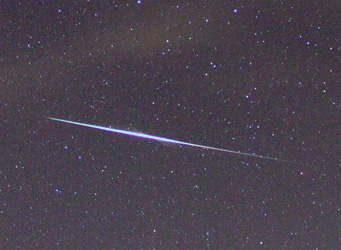The Quadrantids, which peak on the morning of January 3rd, is one of the year's best meteor showers. But whereas showers are usually spread out over several days or even weeks, most of the meteors in this display arrive over just a few hours.
You can start your new year off right, skywatching-wise, by taking in the Quadrantid meteor shower. It peaks on Thursday morning, January 3rd, with the best viewing opportunity between 1 a.m. and dawn. As always, try to observe the shower from the darkest possible location. This year there's competition from a waning gibbous Moon, whose scattered light will wash out the faintest of these "shooting stars."

Not until early morning does the radiant of the Quadrantid meteor shower start to rise high. (And don”™t expect to see several at once!) This scene is for 40° north latitude.
Sky & Telescope illustration
Depending on your point of view, the "Quads" are the least-known major meteor shower or the best of the minor showers. They can be quite intense, with some people reporting more than one meteor per minute from dark observing sites. But whereas most showers are spread out over several days or even weeks, most of the Quadrantids fall in just a few hours.
So your location is critical — you'll only see a spectacular display if the shower's radiant is high in the sky close to the time when the most meteoroids are hitting Earth's atmosphere. For 2013, Canadian meteor experts Margaret Campbell-Brown and Peter Brown predict peak activity around 13:00 Universal Time (5:00 a.m. PST), which favors observers in far western North and South America, the Pacific, and (before dawn on the 4th) easternmost Asia.
This shower gets its name from the obsolete constellation Quadrans Muralis, the Mural Quadrant, that was located in a dim region about halfway from the end of the Big Dipper’s handle to the head of Draco. That's where these meteors appear to radiate from as they arrive. Their source is not a comet, as is typical for showers, but rather an asteroid called 2003 EH1. Dynamicists suspect it is a dead chunk of a comet that broke apart several centuries ago, and that the meteors are small bits of debris from this fragmentation.

It's the only Quadrantid meteor captured by Maryland skywatcher Mike Hankey during 10 hours of photography, but it's a doozy. Click here for a larger view.
Mike Hankey
Because the Quadrantids are so brief, and because they're only visible from northerly latitudes at the coldest time of night during the coldest part of winter, this shower isn't very well documented. There's a strong suspicion that the Quadrantids vary a lot from one year to the next, but this might just be a statistical fluke due to the relatively small number of reports. That makes your observations particularly valuable. See our article on Advanced Meteor Observing and the International Meteor Organization website to find out how to prepare a scientifically useful report.
Finally, make sure to stay warm. Bundle up in as many clothes as possible, paying especial attention to your head, and then snuggle into a warm sleeping bag. Relax in a reclining chair to keep you off the cold ground, and if possible, put an insulating pad between the chair and your sleeping bag. And don't forget to have fun!
For details about the visibility of other flashy displays of shooting stars coming up this year, check out Meteor Showers in 2013.
 8
8









Comments
Niel Skousen
December 28, 2012 at 11:46 am
Thanks again... ever thought of posting calender (.ics) files with the blog's ? some of us 'casual' astronomers arent in the disciplined habit of calendaring all the events, and having the 5~6 top events migrate easily to my calendar would be nice.
niel
You must be logged in to post a comment.
John Van Allen
December 29, 2012 at 3:56 am
I am located in the Dominican Republic around 18.4°N by 70°W so the peak suggested by the experts around 1300UT will be in the daytime for me. Do you think it is worth the effort for us to watch in the early morning hours or would we just be wasting our time. The nice thing around here is the temperature which, at say 0500AM, would be around 22°C so cold is not an issue. I will be observing Saturn around then as it is high enough to be out of the bad seeing zone.
Best Regards
John
You must be logged in to post a comment.
Melody Owen
December 29, 2012 at 6:57 am
I live in Wisconsin when will it be best to view this meteor shower what time Central time will it be best to view them?
You must be logged in to post a comment.
Dave
December 29, 2012 at 5:16 pm
Hi Melody,
You might miss the absolute peak because of sunrise but it is still best to view them from around 1AM your local time onwards for as long as you can endure! 🙂
You won't miss too many since you are only an hour or so East of the ideal location.
Good viewing
Dave
You must be logged in to post a comment.
PRF PATRICK MORTON, COLLEAGUES AND STUDENTS
December 29, 2012 at 10:15 pm
HELLO AND GREETINGS!! THE LOS ROBLES ASTRONOMY CLUB,IN MARACAIBO,VENEZUELA WILL HOST A STAR PARTY IN ORDER TO OBSERVE AND ¨TRY¨TO PHOTOGRAPH THE QUADRANTIDS!! ENTRANCE FREE AT THE LOCAL PLANETARY SOCIETY REGIONAL HEADQUARTERS IN AVENIDA EL MILAGRO!! HAPPY NEW YEAR EVERYBODY!!!
You must be logged in to post a comment.
Bruce Berger
January 2, 2013 at 12:03 pm
Will you brave the elements tonight Tony? Maybe we'll see you there...
You must be logged in to post a comment.
Anthony Barreiro
January 2, 2013 at 4:00 pm
John, I think you answered your own question. If you're already going to be out observing Saturn, and the weather is balmy, why not take a few breaks to lie down and look up into the sky? You might see some meteors! And if not, you can mentally trace the outlines of Ursa Major, Canes Venatici, Coma Berenices, Bootes, Leo, Hydra, Corvus, Virgo, etc.
You must be logged in to post a comment.
Roger
January 2, 2013 at 10:09 pm
Yup, the SkyWeekPlus and SkyWeek Apps missed mentioning this show! I saw it on CNN.
Maybe the Sky... Apps will do better next year. I hope so!!
You must be logged in to post a comment.
You must be logged in to post a comment.